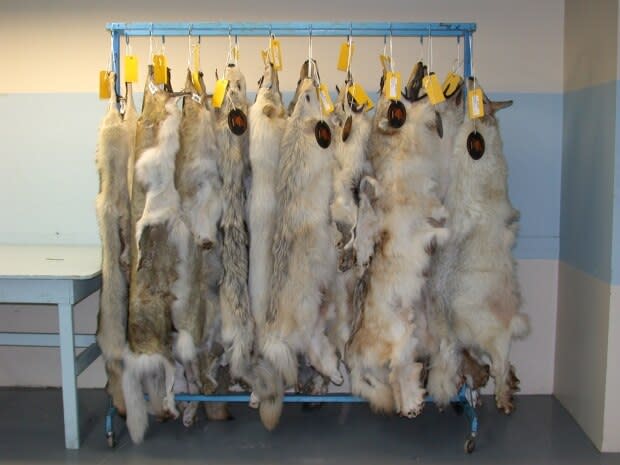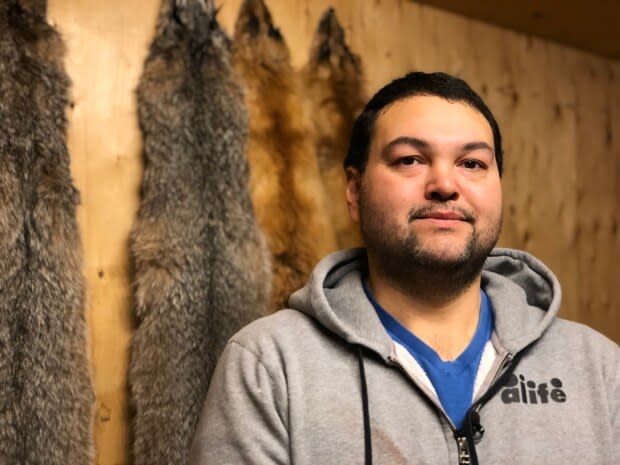Wolf incentive harvest program targets more wolves in caribou winter range
Dozens of wolves were killed by hunters under a new incentive program last year. But a biologist with the territorial government says it's too soon to say if the program is helping caribou.
The territorial government launched the Enhanced North Slave Wolf Harvest Incentive Program last winter. It was designed to support the recovery of barren-ground caribou herds that have been in rapid decline by culling a key predator — wolves.
The program drew criticism in the past from biologists who questioned its efficacy.
The territorial government said hunters harvested 59 wolves in the new harvest area last year. Seven others were harvested outside the new area.
That's an increase from 40 wolves in 2017/18, according to Robert Mulders, a carnivore biologist with the territorial government.
"There's a lot of concern about the role of predators — in particular, wolves," said Mulders. "The objective is to put more harvest pressure on the wolves."
"There's a fair bit of interest with more tags being sold," he said.
Demand for tags nearly tripled in 2018/19, with 1,057 tags awarded, according to a recent North Slave operational report.

Under the program, the territorial government paid hunters $900 per wolf pelt harvested in the incentive harvest zone, and up to $1,650 per animal, depending on the quality of the pelt.
Many of the wolves harvested were in "reasonably good shape" and taken within ten to 20 kilometres of the winter road, said Mulders.
Necropsies confirmed 95 per cent of those wolves had eaten caribou. Previous versions of the incentive program saw many hunters trapping wolves near dumps and communities.
Mulders said at least now they know trappers are harvesting in areas where there's lots of caribou.
"Definitely a step in the right direction here," said Mulders, who noted launching the program in February could account for the moderate increase in animals harvested.
"The literature and other jurisdictions that have done this have suggested you do have to remove 60 to 80 percent of the wolf population and keep that pressure up for a number of years to be effective," he said, "so that's definitely something we're striving for."

For Inuvialuit trapper Nathan Kogiak, each wolf pelt counts.
"I was raised on caribou," said Kogiak, who lives in Yellowknife and regularly traps lynx.
He jumped at the chance to take part in a program that could help caribou herds recover.
"If this is the one thing we can do right now, then of course I'm going to participate," he said.
Kogiak says a cull of 59 wolves is "pretty good" considering how vast their range is.
And the incentive makes it easier to get way out on the land.
"Going for a wolf inside the zone to me is worth it. That's 900 bucks," he said, per pelt. With the expense of gas, he said, "it made a difference."

'Hundreds of wolves' could be harvested
The territorial government did not have any firm targets for last year's wolf incentive harvest program, though management plans for the Bathurst herd suggest harvesting 80 and 120 wolves, said Mulders.
He says the territorial government, and other jurisdictions in Canada, don't have a good handle on how many wolves there are.
"It's a vast area, a huge chunk of real estate," he said, referring to their range.
"The challenge is that not having reliable measures of wolf abundance makes it difficult to set those target levels," he said. There's also variability in the number of caribou herds in the winter range.
"We do think significantly more wolves could be taken, particularly on the barrens. People get out on their snow machine and move away from the winter road," he said.
If those areas were harvested, "we could be into the hundreds of wolves," he said.
The territory is going even further this year to get hunters involved.
Wolf tags cost $22 last year, but this year, they'll be free. Wolf pelt preparation and harvesting workshops will be held in North Slave communities.
"It's very urgent," said Mulders. "The Bathurst and Bluenose-East herds are in significant decline.... It's just finding an approach that the co-management partners will support."


